It’s not November until tomorrow, but Andy Lee Robinson has just published the 2021 edition of his long running “Arctic ice cube” video series, based on the PIOMAS volume data. Here it is for your edification:
You may also wish to keep tabs on our deep dive into CERES top of the atmosphere energy flux data. Here’s a sneak preview:
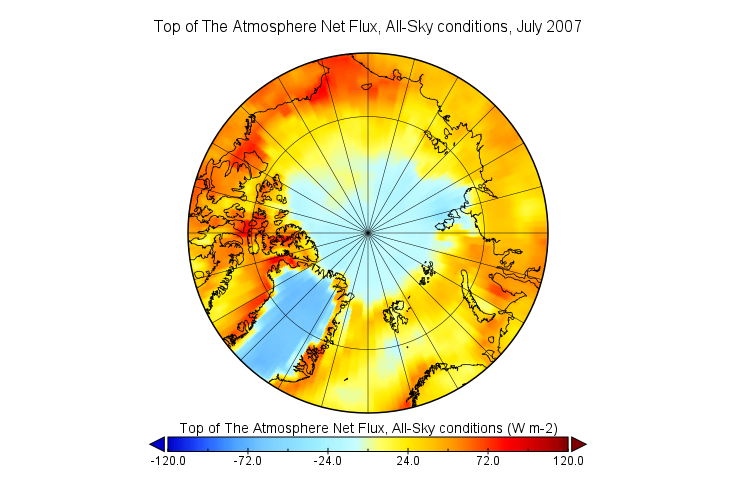
In stark contrast to other recent years, northern hemisphere snow cover is very low at the moment:
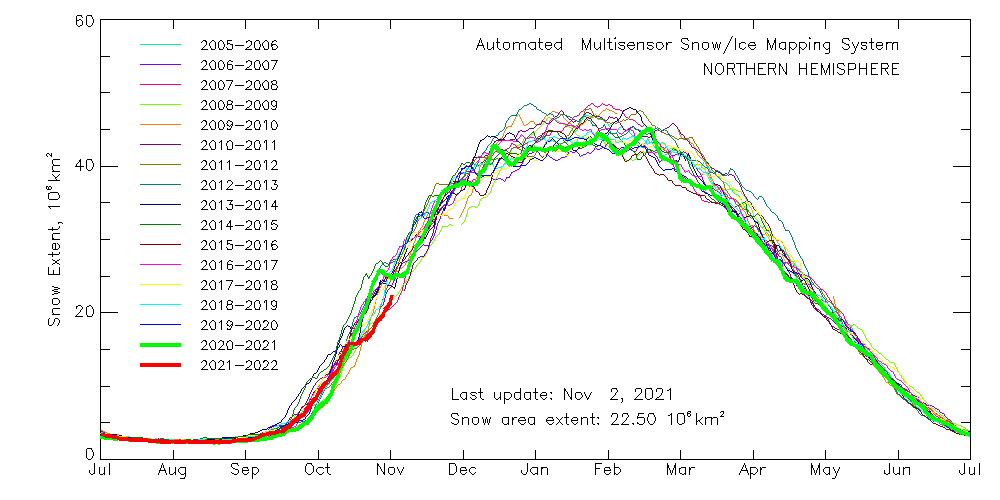
Rutgers Snow Lab data shows that this is especially the case in North America
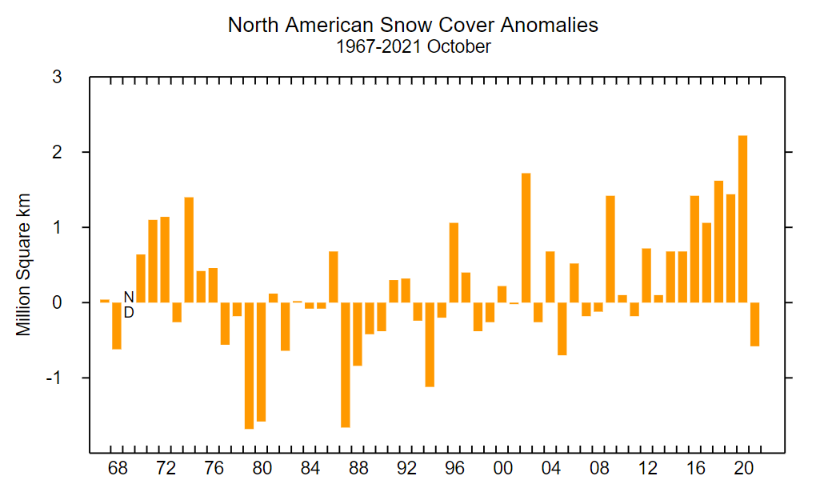
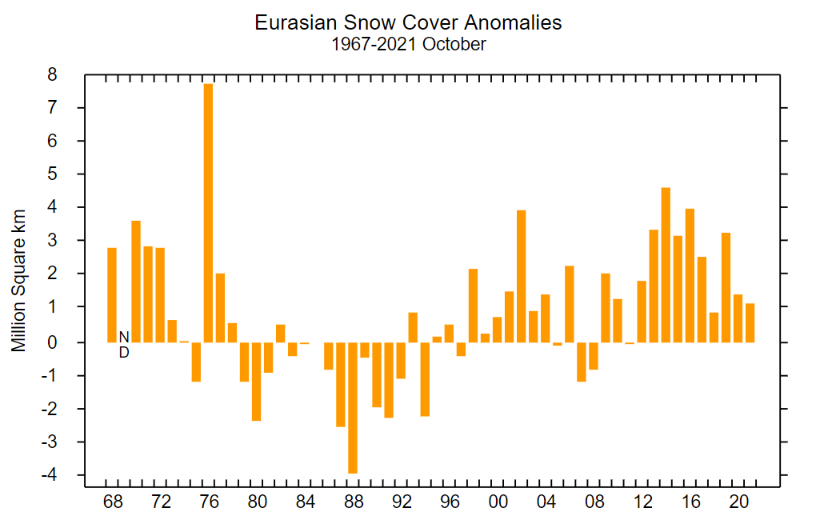
An updated animation of the Northern Sea Route ice cover this year, illustrating the rapid refreeze of the East Siberian and Laptev Seas:
As suggested by the animation above, now that the ESS and Laptev Sea have frozen over, high resolution AMSR2 Arctic sea ice extent has been “flatlining” for a few days:
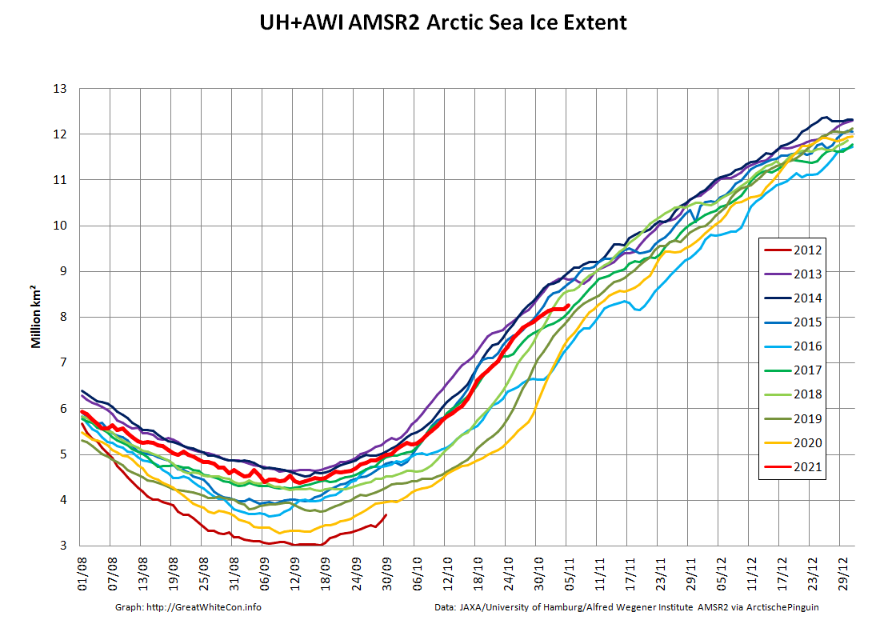
Sea ice area has even decreased slightly:
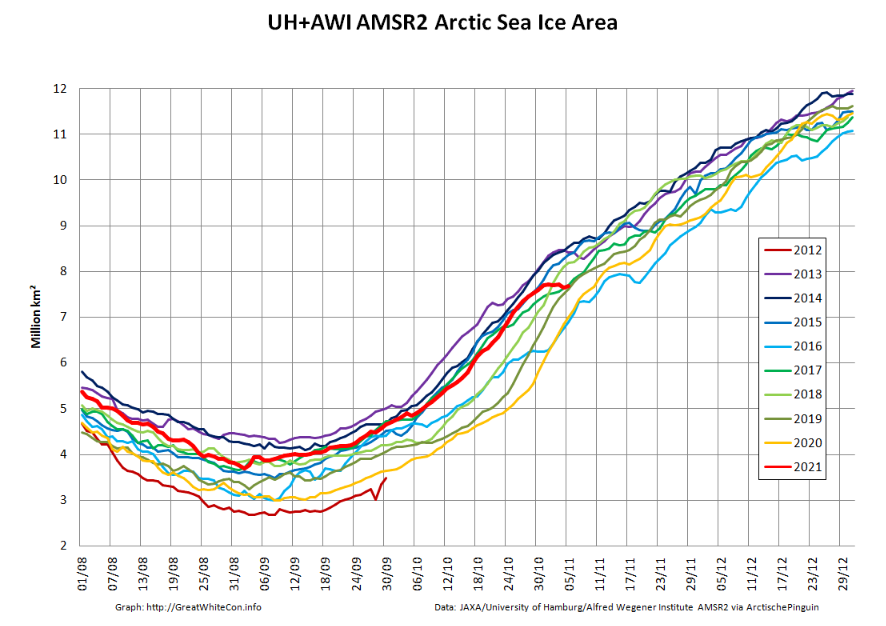
Here too are the latest CryoSat-2/SMOS thickness/volume data:
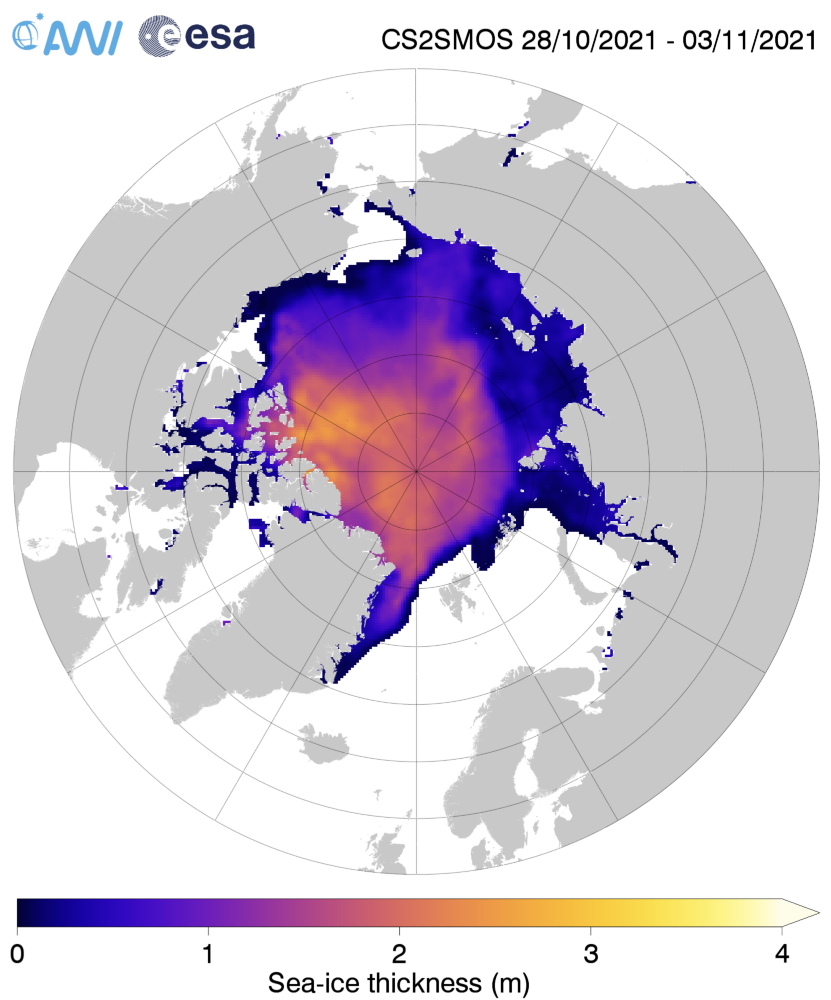
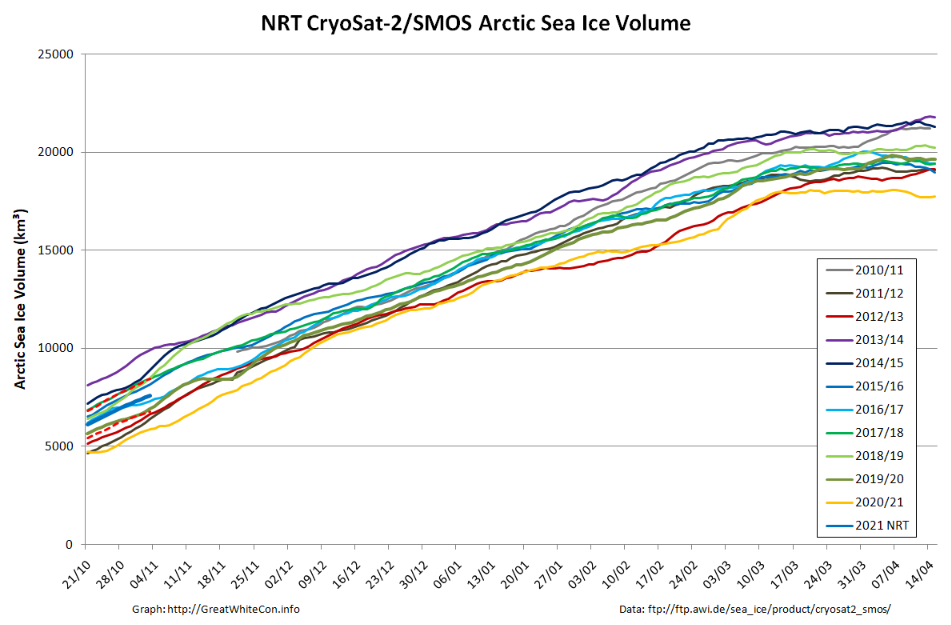
As discussed below, I’ve been on COP26 duty for a couple of weeks. Somewhat belatedly, here are a pair of the Polar Science Center’s PIOMAS model visualisations for October 2021:
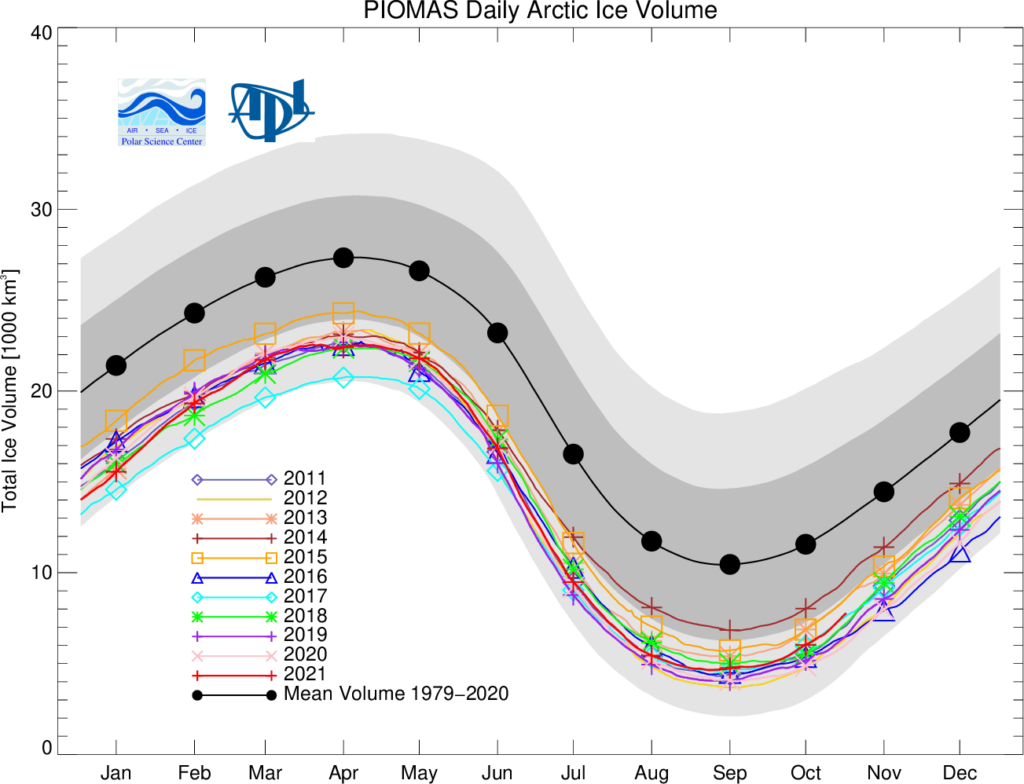

as well as their AWI CryoSat-2 thickness anomaly map:
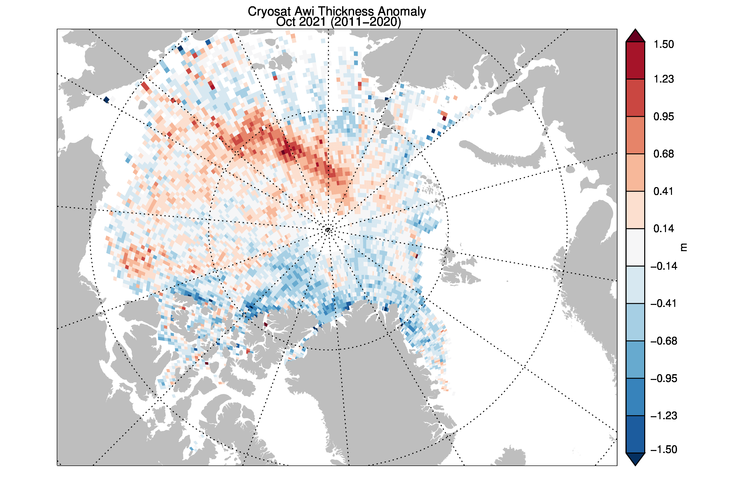
There is broad agreement between model and measurement about the so called “last ice area” being thinner than the climatology, with the Siberian side of the Arctic sporting thicker ice than “normal”.
See Frozen Earth’s comment below for all the accompanying text, but in summary:
[Edit – November 22nd]Average Arctic sea ice volume in October 2021 was 6,140 km3. This value is the 8th lowest on record for October, about 1200 km3 above the record set just last year
According to a certain “skeptical” fellow “It’s very cold in the Arctic today”.
Let’s take a look at the skeptics’ favourite temperature metric shall we?

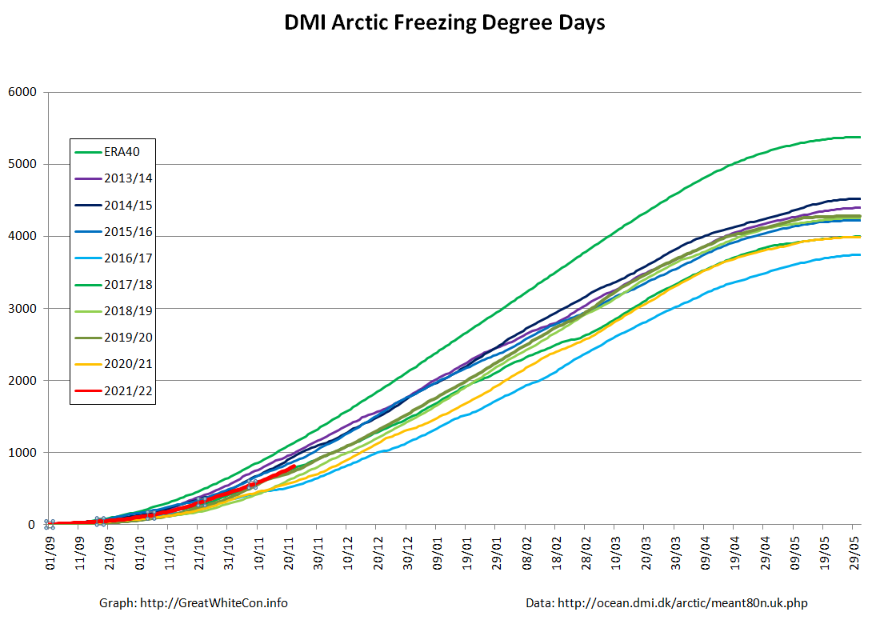
Q.E.D?
For further Arctic sea ice news please see the new December thread:
https://GreatWhiteCon.info/2021/12/facts-about-the-arctic-in-december-2021/
According to the Barents Observer:
What struck me today was how close we are to a tipping point in our points of view.
Yourself and Tamino consistently put forward worrying interpretations yet others put ones pushing a recovery.
The difference between a Wadhamless Arctic and a 19 th lowest this coming year seems to equally weighted by the opposing arguments and facts.
I’m not sure if a ‘recovery’ wouldn’t be ‘worrying’ as well. CAGW proponents try to portray warming and lower sea ice as dangerous, but a return to Little Ice Age conditions of a few hundred years ago would be at least as dangerous to our current civilization. History teaches that times of warm climate are coincident with civilization growth and success and human wellbeing. Cold periods, not so much.
Doesn’t that rather depend on exactly how “warm”?
A return to “Little Ice Age” conditions seems exceedingly unlikely at present? As does limiting warming to 1.5 °C!
I’m sure the return to the Little Ice Age from the MWP came as quite a shock to the Vikings as well, but it did happen. Forces more powerful than CO2 are loose in the world, we just don’t understand them very well.
Like volcanoes you mean?
https://en.wikipedia.org/wiki/1257_Samalas_eruption
Evenin’ Angech,
Bear in mind that a few of know what we’re talking about whilst a host of others do not!
Drifting off topic only slightly, and channeling Eric Morecambe, evidently “there’s no answer to that”:
I can see the headline in the Guardian now: “Victims of Climate Change rescued by Russian nuclear icebreaker”. I won’t hold my breath…
The Grauniad seem to be blissfully unaware of the NSR story. I recommend keeping an eye on those that know what they’re talking about:
Thanks for the link, Jim. Most helpful set of facts and much preferred over the hysteria one often finds in some media outlets these days.
The media has always dominated the public: that’s how advertising and capitalism work
What’s this new Arctic trend of yourself and Arctic Sea Ice Forum not even noticing when a new MONTH of sea ice volume data is out??? I tell you it’s worrying, that’s what it is!
I wrote a tiny little bot that delivers me the goods, I may set it free on the webs once the first batch of bugs are deloused, in a month or two.
«October 2021 Monthly Update
Average Arctic sea ice volume in October 2021 was 6,140 km3. This value is the 8th lowest on record for October, about 1200 km^3 above the record set just last year (October record for volume is in 2020 while for September it is 2012). Monthly ice volume was 72% below the maximum in 1979 and 57% below the mean value for 1979-2020. Average October 2021 ice volume was about one sigma above the 1979-2020 trend line. October saw relative rapid ice growth for recent years (Fig 4) bringing the mean ice thickness (above 15 cm thickness) above the near records analyzed for September. The ice thickness anomaly map for October 2021 relative to 2011-2020 (Fig 6) continues to show anomalies divided into positive and a negative halves. Negative anomalies stretching from North of Greenland and along the Canadian Archipelago across the Eastern Arctic into the Barents Sea. Areas North of Greenland again feature very low ice thickness as in prior years (see our recent paper). Positive anomalies are notable in the Beaufort and Chukchi seas due to advection of thicker older ice into the areas during the previous winter (See recent paper on this). The Alaskan summer has also been relatively cold contributing to unusually thick ice in this area. CryoSat 2 ice thickness, now back online after the regular summer hiatus, shows a similar picture sea ice thickness anomalies but with the maxima slightly displaced which maybe due to temporal sampling of the composite.
The October time series (Fig 8) for both data sets have no apparent trend over the past 11 years. Comparing this with the 43 year 1979-2021 time series highlights the importance of natural variability in relatively short time series such as currently available from CS2. Both records show close match in magnitude and similar temporal variability, including the uptick from 2020. However, while PIOMAS shows a maximum ice volume in 2014, CS2 records it in 2013.
Updates will be generated at approximately one-month intervals.»
I’m afraid I’ve been extremely busy on COP26 matters over the last few days FE, amongst many other things:
https://twitter.com/jim_hunt/status/1459635524457713669
Normal service will be resumed shortly, but since it’s well past my bedtime yet again that will have to wait until much later this morning (UTC).
Understandably.
As CarbonTracker has revealed, keeping their promises *WILL* take us to 2.4C warming from pre-industrial, so in this case let’s hope they will NOT stick to their (genocidal) promises, eh?
Because otherwise the COP in Glasgow may end up looking like the Wannsee Conference in retrospect.
Let’s hope for 2.4 degrees at least, which will allow us to name this period the “Modern Climate Optimum” which , like the Medieval Climate Optimum and the Roman one before it, led to great advances in civilization. Besides, we need the resulting crop productivity to feed all the population growth.
Why do you just think about yourself???
Well, our friends over at PIOMAS have finally weighed in on October: volume up 25% over previous low last year, again ‘no apparent trend for 11 years’. They also note that this is an example of how ‘natural variability’ can sometimes overcome longer term trends.
Hopefully this kind of analysis will lead to funding actual studies of natural variability, vs. enormous funding for anything that blames the ‘trace gas plant food’ that politicians and hysterical teenagers seem so worried about.
Thanks for demonstrating so delicately how Seattle scientists at UW are the true source of climate cherry picking. Who needs deniers when this is scientists doing it themselves, all the time.
Oh. 11 years is the new normal period for climatologists, is it?
Might be cool this month. I thought it would be for the last 4 months but UAH and GISS kept showing it high.
Some chance therefore of further freezing if the global temperatures are down ?
Depends on where you look, angech. Alaska right now having a brutal fall, the Chukchi Sea is iced over earlier than normal, and the Bering is starting to accumulate ice. Here in Maine we’ve had a very mild fall. It’s that ‘Natural Variability you’ve heard so little about…
I highly doubt the POIMAS folks would qualify as ‘deniers’ (a term I detest), nor ‘cherry-pickers’. They crank their models and report the results with, I think, the hope that their data proves the AGW case. For them to point out the ‘no trend’ situation is a function of simple truth-telling, but neither they nor I, for that matter, claim that such a pause proves anything. Make it 20 or certainly 30 years of no trend, then maybe there would be a case for a shift in climate. Their point was about natural variability overcoming trends in the short term. Stop ‘pearl-clutching’. Maybe in a few years the ice will go down again and your faith in CAGW will be vindicated (or maybe it won’t go down, and you’ll really need to panic).
I thought you wanted warming? Perhaps you’re hysterical …
Hmm! There are 15 ships stuck in the ice up in the Arctic, yet there is very little news about it within the media.
It doesn’t fit the warmist agenda!
Don’t be daft Neil. It certainly fits the “skeptical” agenda to bleat about it though!
For a reasoned take from experts in these matters please see:
And that early freeze-up in 1983 was in September, shows how much things have changed.
See Barr and Wilson (1985):
https://pubs.aina.ucalgary.ca/arctic/Arctic38-1-1.pdf
But Taylor just said she wanted warming: don’t tell me you’re both hysterical ….
SpeakMyLanguage: you seem to have an unusual definition of ‘hysterical’. I have a good reason for wanting it a bit warmer and with a bit more CO2, and very good reasons for not wanting it colder, with less CO2. However, unlike most of the hubris-laden CAGW crowd, I have little faith that we can do anything ourselves to achieve either outcome. I do, however, have great interest in anything/anyone who can accurately predict which scenario might actually happen.
So, Taylor, you want an accidentally geo-engineered climate?
That’s the very definition of hysterical in my, and I dare say every other person on the Internet’s, book lol
Still can’t find anything anywhere telliing me what has happened to these 15 ships. Are they still stuck there or have they got through?
I just found this article with background on what the current sea ice situation is. It will probably be like this for a few more weeks.
https://www.highnorthnews.com/en/early-winter-freeze-traps-ships-arctic-ice-highlighting-weak-safety-regime
Thanks very much David.
Now found this site
https://arctic-lio.com/category/news/
Seems to give daily updates of the progress of all the ships.
Very detailed.
Most seem to be making progress
There seems to be a convoy following an icebreaker in the eastern Laptev Sea, plus one ship still stuck on its own far to the north west:
https://www.marinetraffic.com/en/ais/home/centerx:121.8/centery:77.8/zoom:6
The convoy seems to have made some progress towards the Vilkitsky Strait, and an icebreaker is heading for the cargo vessel apparently stuck at ~78N
Slowing down again. Would need the Bering Sea to get up to speed for further advancement.
30% chance.
In the latest news from the Laptev Sea, all the previously stuck ships now seem to be making headway towards the Vilkitsky Strait:
Jim,
Just a quick note to say that your last (22 Nov) post above doesn’t seem to be aging well. The DMI metric you cited now reads -28C, and Arctic temps this year only were briefly lower three times (late Jan and mid Mar). I’m not sure what’s driving it, but the recent plummet in temps does seem to be having an effect on the ice. NSIDC shows extent growing faster than normal for the month, and DMI as well for volume. We’ll see where PIOMAS lands in due time, but something is definitely and recently up in the Arctic, including SMB in Greenland.
BTW, I noticed that several of my replies, including one to ‘SpeakMyLanguage’, seem to have disappeared – is GreatWhiteCon affected by the WUWT disease?
Oops, sorry, the comments now have reappeared. May be my browser. Will be more careful next time before jumping to conclusions
Hi Taylor,
Fairy Nuff!
In answer to your final paragraph.
No!
See also:
The Northern Sea Route convoy has successfully made it through the Vilkitsky Strait.
Zoom in to discover how many ships are actually involved: